 Technology peripherals
Technology peripherals
 AI
AI
 Explore the origins of nature! The seventh bullet of Google's 2022 year-end summary: How can 'Biochemical Environmental Materials” reap the dividends of machine learning?
Explore the origins of nature! The seventh bullet of Google's 2022 year-end summary: How can 'Biochemical Environmental Materials” reap the dividends of machine learning?
Explore the origins of nature! The seventh bullet of Google's 2022 year-end summary: How can 'Biochemical Environmental Materials” reap the dividends of machine learning?
With huge advances in machine learning and quantum computing, we now have new and more powerful tools to collaborate with researchers across industries in new ways and radically accelerate the progress of groundbreaking scientific discoveries. .
The theme of this year-end summary of Google is "Natural Science". The author of the article is John Platt, an outstanding scientist at Google Research. He graduated from the California Institute of Technology with a Ph.D. in 1989 University.

Since joining Google Research eight years ago, I have been privileged to be part of a community of talented researchers dedicated to Focused on applying cutting-edge computing technologies to advance the possibilities of applied science, the team is currently exploring topics in the physical and natural sciences, from helping to organize the world's protein and genomic information to benefit people life, to using quantum computers to improve our understanding of the nature of the universe.
Use machine learning to solve the mysteries of biology
The extraordinary complexity of biology has fascinated countless researchers, from exploring the mysteries of the brain to exploring the structure of proteins , to the genome encoding the language of life, Google has been collaborating with scientists from other leading organizations around the world to address grand challenges in connectomics, protein function prediction, and genomics, and to make innovations available to the broader community. used by the scientific community.
Neurobiology
In 2018, an application developed by Google is to explore information is transmitted through neuronal pathways in the zebrafish brain, providing insight into how zebrafish engage in social behaviors like swarming.
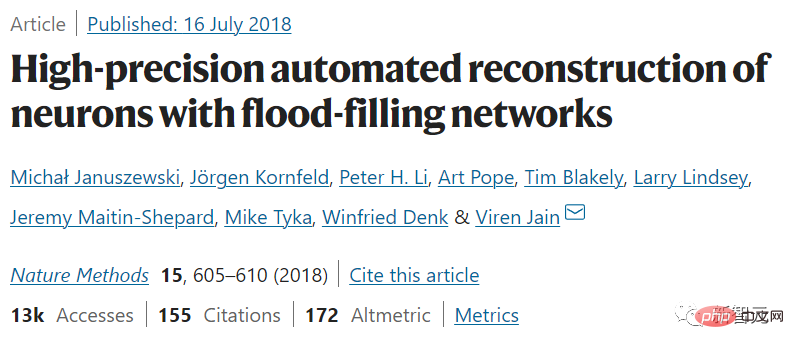
Paper link: https://www.nature.com/articles/s41592-018-0049-4
Working with researchers at the Max Planck Institute for Biology Intelligence, researchers used computers to recreate part of a zebra 3D electron microscope image of a fish brain.
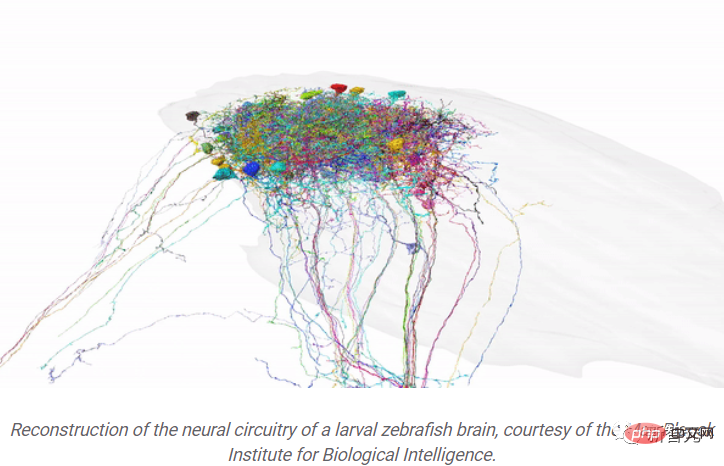
This is also a milestone in the use of imaging and computational pipelines to map neuronal circuits in the cerebellum, It is also another advancement in the field of connectomics.
The technology involved in this work can even be applied to fields beyond neuroscience. For example, to solve the problem of processing large connectomics data sets, researchers at Google developed and Released TensorStore, an open source C and Python software library specifically designed to store and operate n-dimensional data, and is also suitable for storing large data sets in other fields.
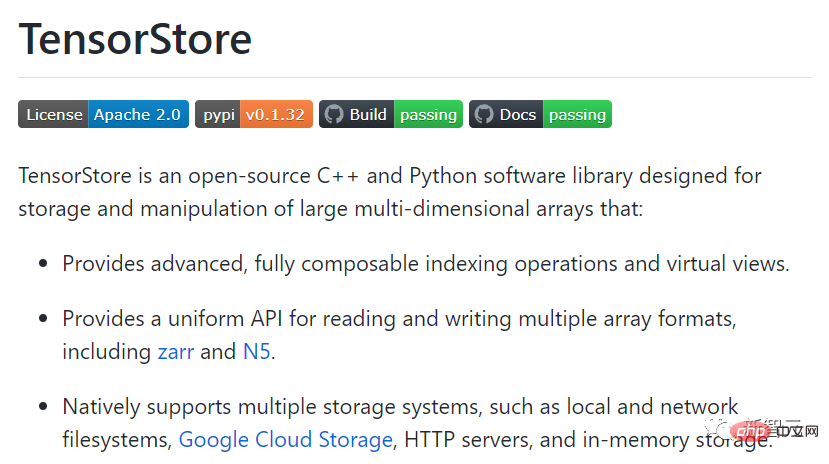
## Code link: https://github.com/google/tensorstore
By comparing human language processing to autoregressive deep language models (DLMs), researchers have used machine learning to shed light on how the human brain performs functions as distinctive as language.
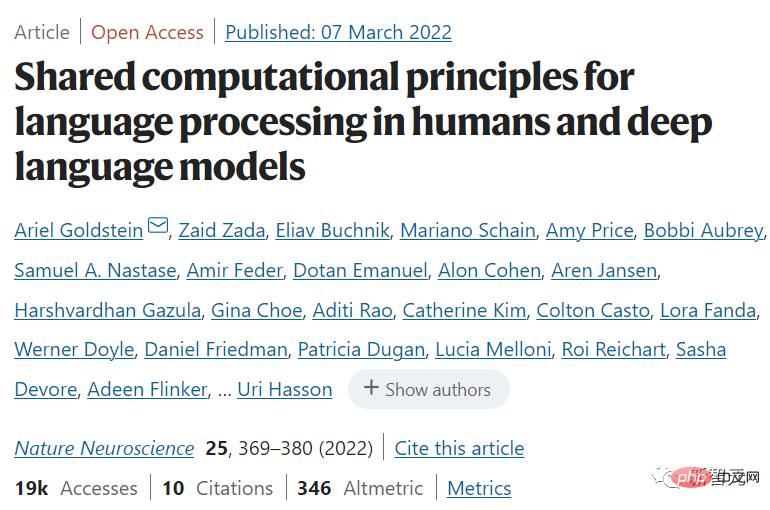
Paper link: https://www.nature.com/articles/s41593-022-01026 -4
In this study, Google teamed up with researchers from Princeton University and NYU Grossman School of Medicine to have participants listen to a 30-minute podcast. Their brain activity was also recorded using electrocorticography.
The recorded results show that the human brain and DLM share computational principles for processing language, including continuous next word prediction, context-dependent embedding, and post-onset suprise calculation based on word matching, that is, the human brain can measure The degree of surprise of the word and correlate the surprise signal with the degree of prediction of the word by DLM.
These results provide new conclusions about language processing in the human brain and suggest that DLM can be used to reveal valuable insights into the neural basis of language.
Biochemistry
Machine learning has also led to significant advances in understanding biological sequences Progress, researchers leverage recent advances in deep learning to accurately predict protein function from raw amino acid sequences.
Paper link: https://www.nature.com/articles/s41587-021-01179-w
Google is also working closely with the European Molecular Biology Laboratory's European Bioinformatics Institute (EMBL-EBI) to carefully evaluate the performance of the models and has added hundreds of millions to the public protein databases UniProt, Pfam/interPro and MGnify function annotation.
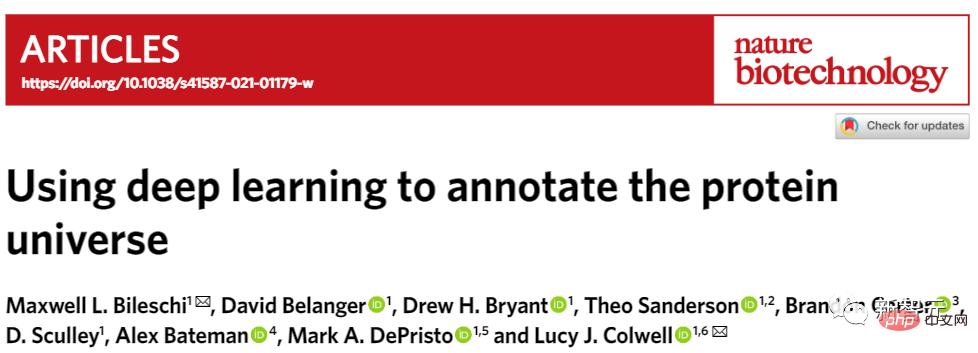
Paper link: https://www.nature.com/articles/s41587-021-01179 -w.epdf
Human annotation of protein databases may be an arduous and slow process, but the machine learning method proposed by Google has made the annotation speed a huge leap. .
For example, Pfam has added more annotations than all other efforts combined in the past decade, and the millions of scientists around the world who access these databases each year can now leverage that annotation for research. .
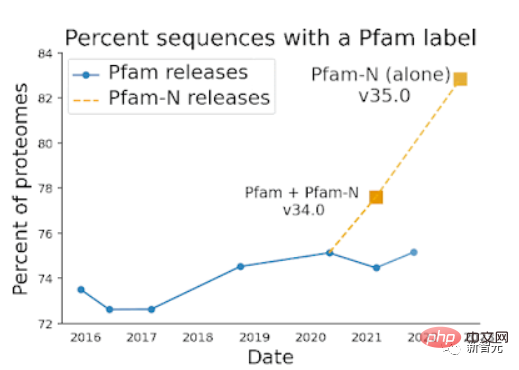
Although the first draft of the human genome was released in 2003, it was not completed due to technical limitations of sequencing technology. incomplete.
In 2022, the Telomere-2-Telomere (T2T) consortium is addressing these previously unobtainable regions (including 5 complete chromosome arms and nearly 200 million bases of new DNA sequence). Remarkable achievements have been made in studying areas that are both interesting and important to questions of human biology, evolution, and disease.
Google's open source genome variant caller, DeepVariant, is one of the tools used by the T2T Consortium to prepare for the release of a complete 3.055 billion base pair human genome sequence.
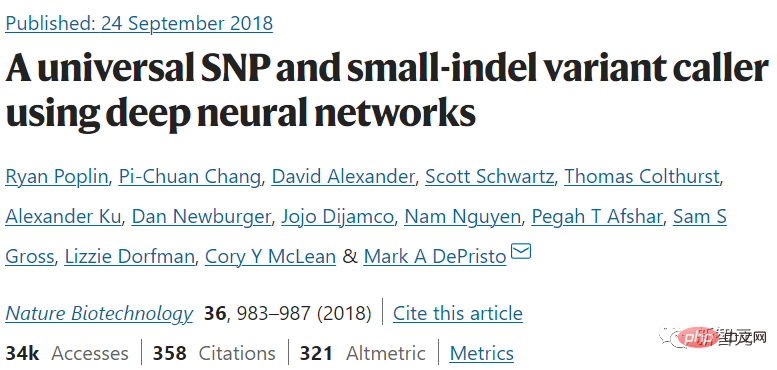
## Paper link: https://www.nature.com/articles/nbt.4235
The T2T consortium is also using Google’s open-source approach DeepConsensus to provide on-device error correction for Pacific Biosciences long-read sequencing instruments, in T2T’s latest study of comprehensive pan-genome resources. , can represent the breadth of human genetic diversity.
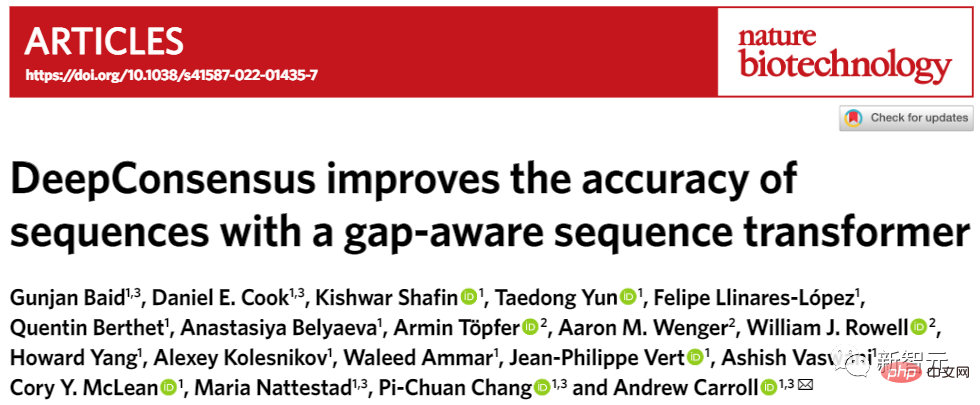
Paper link: https://www.nature.com/articles/s41587-022-01435 -7.epdf
Application of quantum computing in new physical discoveriesQuantum computing is still in its infancy in promoting scientific discovery, but it has There is great potential, so Google is exploring ways to improve quantum computing capabilities so that quantum computing can become a tool for scientific discoveries and breakthroughs.
By collaborating with physicists from around the world, the researchers are starting to use existing quantum computers to create completely new physics experiments. One of the quantum experimental problems is: when a sensor measures a When detecting objects, a computer is needed to process the data from the sensors.
In the traditional processing process, the sensor data needs to be converted into classical information before processing.
For quantum computing, quantum data from sensors can be directly processed, and the data from quantum sensors can be directly provided to quantum algorithms without measurement, which will have greater advantages than traditional computers.

Paper link: https://www.science.org/doi/10.1126/science.abn7293
In a Science paper recently published by Google in collaboration with researchers from multiple universities, experimental results show that as long as a quantum computer is directly coupled to a quantum sensor and runs a Learning algorithms, quantum computing can extract information from far fewer experiments than classical computing.
Even on currently immature mid-scale quantum computers, "quantum machine learning" can produce exponential advantages on data sets.
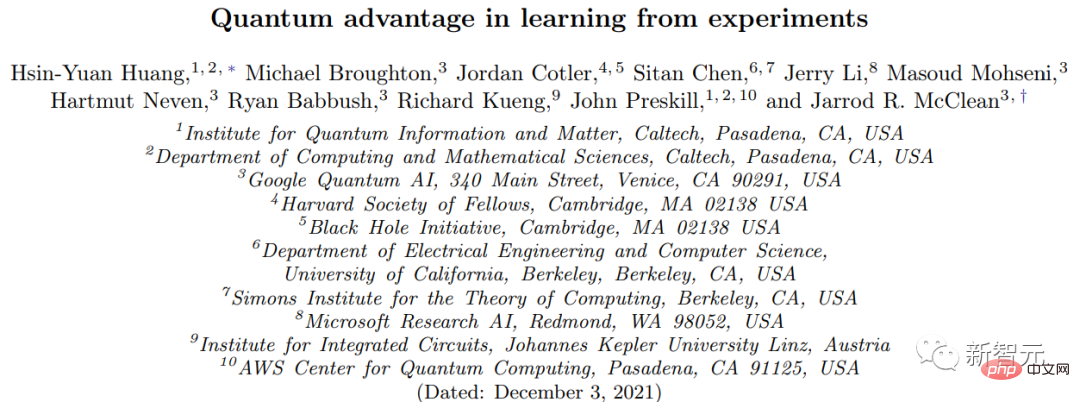
Paper link: https://arxiv.org/abs/2112.00778
Since experimental data is often the limiting factor in scientific discovery, quantum machine learning algorithms have the potential to fully unleash the power of quantum computers. What’s even better is that the results of this work also apply to learning The output of quantum computing, such as the output of quantum simulations, is difficult to extract.
Even without quantum machine learning, a promising application of quantum computers is the experimental exploration of quantum systems that cannot be observed or simulated.
In 2022, the Quantum AI team used this method to observe the first experimental evidence of multiple microwave photons in a bound state using a superconducting qubit.
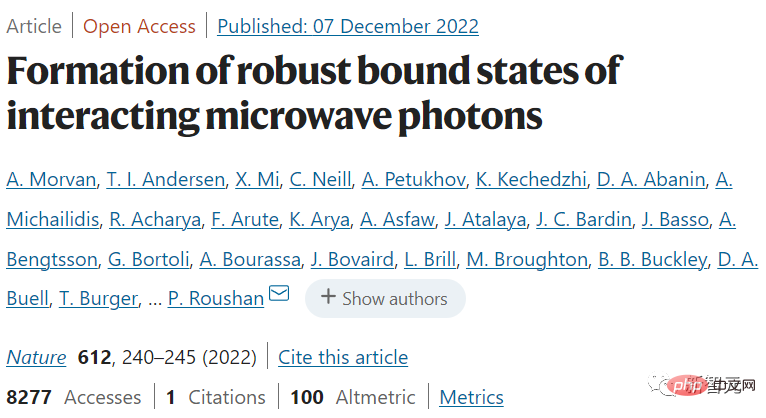
Paper link: https://www.nature.com/articles/s41586-022-05348 -y
Photons usually require additional nonlinear elements to interact, and Google's quantum computer's simulation of these interactions surprised the researchers: They originally expected these The existence of bound states relies on fragile conditions, but they were actually found to be robust even to relatively strong perturbations.

Given Google’s initial success in applying quantum computing to achieve breakthroughs in physics, researchers are excited about the technology The possibilities also hold great promise, allowing future breakthrough discoveries to have as significant a social impact as the creation of the transistor or the Global Positioning System.
Quantum computing as a scientific tool is very promising!
The above is the detailed content of Explore the origins of nature! The seventh bullet of Google's 2022 year-end summary: How can 'Biochemical Environmental Materials” reap the dividends of machine learning?. For more information, please follow other related articles on the PHP Chinese website!

Hot AI Tools

Undresser.AI Undress
AI-powered app for creating realistic nude photos

AI Clothes Remover
Online AI tool for removing clothes from photos.

Undress AI Tool
Undress images for free

Clothoff.io
AI clothes remover

AI Hentai Generator
Generate AI Hentai for free.

Hot Article

Hot Tools

Notepad++7.3.1
Easy-to-use and free code editor

SublimeText3 Chinese version
Chinese version, very easy to use

Zend Studio 13.0.1
Powerful PHP integrated development environment

Dreamweaver CS6
Visual web development tools

SublimeText3 Mac version
God-level code editing software (SublimeText3)

Hot Topics
 1377
1377
 52
52
 How to comment deepseek
Feb 19, 2025 pm 05:42 PM
How to comment deepseek
Feb 19, 2025 pm 05:42 PM
DeepSeek is a powerful information retrieval tool. Its advantage is that it can deeply mine information, but its disadvantages are that it is slow, the result presentation method is simple, and the database coverage is limited. It needs to be weighed according to specific needs.
 How to search deepseek
Feb 19, 2025 pm 05:39 PM
How to search deepseek
Feb 19, 2025 pm 05:39 PM
DeepSeek is a proprietary search engine that only searches in a specific database or system, faster and more accurate. When using it, users are advised to read the document, try different search strategies, seek help and feedback on the user experience in order to make the most of their advantages.
 Sesame Open Door Exchange Web Page Registration Link Gate Trading App Registration Website Latest
Feb 28, 2025 am 11:06 AM
Sesame Open Door Exchange Web Page Registration Link Gate Trading App Registration Website Latest
Feb 28, 2025 am 11:06 AM
This article introduces the registration process of the Sesame Open Exchange (Gate.io) web version and the Gate trading app in detail. Whether it is web registration or app registration, you need to visit the official website or app store to download the genuine app, then fill in the user name, password, email, mobile phone number and other information, and complete email or mobile phone verification.
 Why can't the Bybit exchange link be directly downloaded and installed?
Feb 21, 2025 pm 10:57 PM
Why can't the Bybit exchange link be directly downloaded and installed?
Feb 21, 2025 pm 10:57 PM
Why can’t the Bybit exchange link be directly downloaded and installed? Bybit is a cryptocurrency exchange that provides trading services to users. The exchange's mobile apps cannot be downloaded directly through AppStore or GooglePlay for the following reasons: 1. App Store policy restricts Apple and Google from having strict requirements on the types of applications allowed in the app store. Cryptocurrency exchange applications often do not meet these requirements because they involve financial services and require specific regulations and security standards. 2. Laws and regulations Compliance In many countries, activities related to cryptocurrency transactions are regulated or restricted. To comply with these regulations, Bybit Application can only be used through official websites or other authorized channels
 Sesame Open Door Trading Platform Download Mobile Version Gateio Trading Platform Download Address
Feb 28, 2025 am 10:51 AM
Sesame Open Door Trading Platform Download Mobile Version Gateio Trading Platform Download Address
Feb 28, 2025 am 10:51 AM
It is crucial to choose a formal channel to download the app and ensure the safety of your account.
 Top 10 recommended for crypto digital asset trading APP (2025 global ranking)
Mar 18, 2025 pm 12:15 PM
Top 10 recommended for crypto digital asset trading APP (2025 global ranking)
Mar 18, 2025 pm 12:15 PM
This article recommends the top ten cryptocurrency trading platforms worth paying attention to, including Binance, OKX, Gate.io, BitFlyer, KuCoin, Bybit, Coinbase Pro, Kraken, BYDFi and XBIT decentralized exchanges. These platforms have their own advantages in terms of transaction currency quantity, transaction type, security, compliance, and special features. For example, Binance is known for its largest transaction volume and abundant functions in the world, while BitFlyer attracts Asian users with its Japanese Financial Hall license and high security. Choosing a suitable platform requires comprehensive consideration based on your own trading experience, risk tolerance and investment preferences. Hope this article helps you find the best suit for yourself
 Binance binance official website latest version login portal
Feb 21, 2025 pm 05:42 PM
Binance binance official website latest version login portal
Feb 21, 2025 pm 05:42 PM
To access the latest version of Binance website login portal, just follow these simple steps. Go to the official website and click the "Login" button in the upper right corner. Select your existing login method. If you are a new user, please "Register". Enter your registered mobile number or email and password and complete authentication (such as mobile verification code or Google Authenticator). After successful verification, you can access the latest version of Binance official website login portal.
 The latest download address of Bitget in 2025: Steps to obtain the official app
Feb 25, 2025 pm 02:54 PM
The latest download address of Bitget in 2025: Steps to obtain the official app
Feb 25, 2025 pm 02:54 PM
This guide provides detailed download and installation steps for the official Bitget Exchange app, suitable for Android and iOS systems. The guide integrates information from multiple authoritative sources, including the official website, the App Store, and Google Play, and emphasizes considerations during download and account management. Users can download the app from official channels, including app store, official website APK download and official website jump, and complete registration, identity verification and security settings. In addition, the guide covers frequently asked questions and considerations, such as



